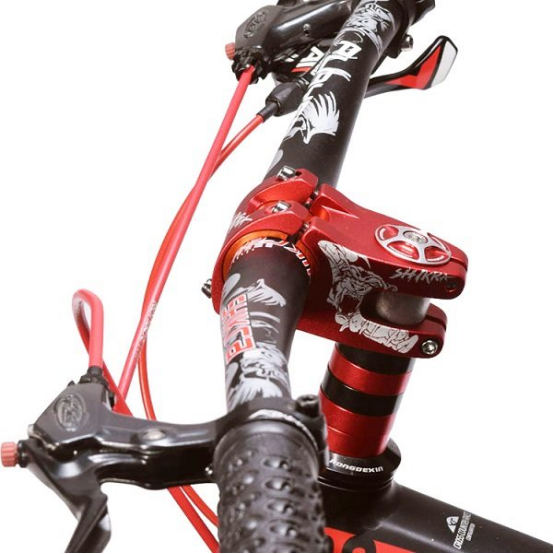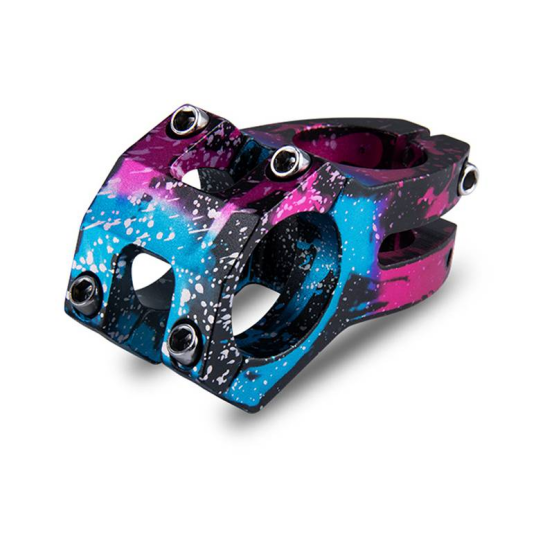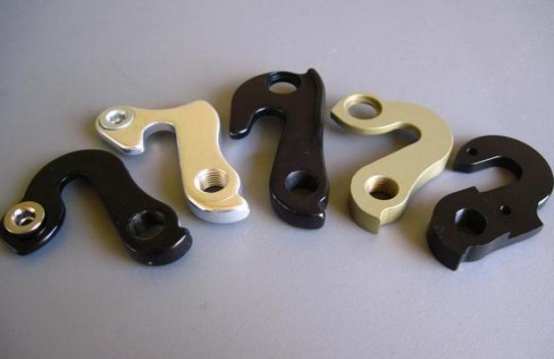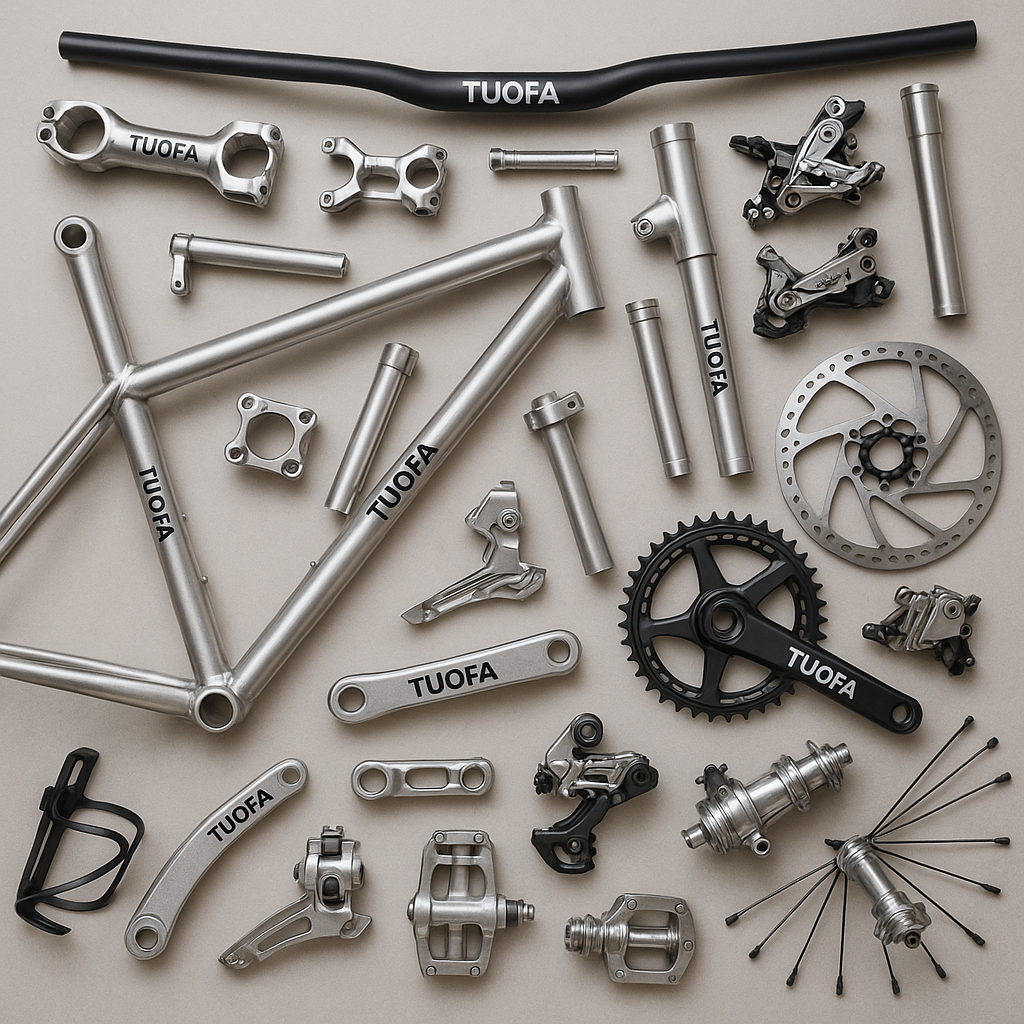Why Choose CNC Custom Bicycle Parts? -Brand CNC Machining Solution China
 May 17,2025
May 17,2025

Why choose CNC custom bicycle parts for your project? This article will guide you through the critical aspects of CNC custom bicycle parts, from material selection to customization options, and help you make the best decision for your project.
What Makes CNC Machining Ideal for Custom Bicycle Parts?
When it comes to bicycle parts, there lots ways and methods to manufacture. Whatever daily commute bikes or high-performance road bikes are very popular among every ages of people.
Today we mainly discuss about CNC precision machining parts, especially for some custom bike types, instead of standard parts.

How Does Precision CNC Machining Enhance Bicycle Performance?
For bespoke bike types, high quality parts are of essential:
1. ±0.02 mm accuracy for seamless assembly
CNC machining stands for Computer Numerical Control Machining. In this way, the computer controls the cutting tool's path, speed, and other parameters based on the instructions provided in the program. And it leads to high accuracy.
Tight tolerances(precision machining can achieve ±0.02 mm) keep bearing seats concentric, pivots smooth, and drivetrains quiet, giving riders crisp power transfer and longer component life.
2. Complex geometries
Among CNC machining, there types of axis machines. For some complex geometries, 5-Axis CNC machining is a common choice. From the perspective of production efficiency, 5-axis CNC production can process more dimensions simultaneously - faster and more accurately.
Multi-axis milling produces hidden cable ports, sculpted brake arms, and lattice stiffeners in one setup, trimming weight while safeguarding strength.
3. Material versatility
A single CNC cell can machine 6061 aluminum in the morning and titanium or engineering plastic in the afternoon, so every part uses the material best suited to its task.
Unlike some other production methods, there are strict requirements on the properties of materials. This provides great flexibility in the selection of customized bicycles parts.
4. Rapid prototyping
How to get a rapid prototype? That's mean the process from CAD to CAM and production run would be short and quick.
Digital CAM files turn sketches into test pieces within days, allowing designers to refine fit, clearance, and feel before committing to a full production run.

Why Are Custom Parts Critical for High-Performance Bicycles?
It depend on what kinds of high-performance bicycles are needed. Lighter parts matter only when stiffness and fatigue life remain high. For an example, replacing a cast e-bike motor shell with a pocket-milled 6061 case cut weight by 210 g; and it lowered peak temperature 8° on test climbs.
Performance changes after switching to CNC parts:
|
Feature |
Cast/Forged |
CNC Machined |
Practical Result |
|
Dimensional tolerance |
±0.15 mm |
±0.02 mm |
Easier press-fits |
|
Minimum wall thickness |
2.5 mm |
0.8 mm |
20–30 % weight drop |
|
Design iteration time |
4–6 weeks |
5–7 days |
Faster updates |
|
Impact strength* |
Baseline |
+15 % |
Longer life |
|
Up-front tooling cost |
High |
Low |
Viable for 50-piece runs to larger projects |
*Typical for 6061-T6 housings after T6 temper.
What's the Most Common Used Material in Bike Parts?
If you take a bicycle as a whole, there are many kinds of parts that make it up: functional and appearance performance. The top 5 materials commonly used in many bicycles on the market are: aluminum alloy, carbon fiber, titanium alloy, stainless steel and magnesium alloy - distributed in various parts.
Popular Bike Types List
- Mountain Bike.
- Road Bike.
- City Bike.
- Hybrid Bike.
- E-Bike.
- Folding Bike.
- Track Bike.
- Touring Bike.
Frames, cockpits, and drive systems rely on a spectrum of alloys and composites. Below are today's top picks.
TOP 1-Aluminum Alloys (6061 / 7075)
Aluminum alloys are definitely favourite materials used in all kinds of bikes. They are prevalent in bicycle manufacturing due to their favorable strength-to-weight ratio and cost-effectiveness. 6061 and 7075 al are both common materials in custom bikes parts:
6061 Aluminum:
Known for its excellent weldability and corrosion resistance, 6061 is commonly used in bike frames and components. It offers a good balance between strength and weight, making it suitable for various cycling applications. Whatever custom daily city bike or road bike, 6061 aluminum is always found.
- AL6061-T6: Custom City Commute/Road Bike Structural Parts
With a tensile strength of approximately 310 MPa and yield strength around 276 MPa, AL6061-T6 is commonly used in bicycle frames, handlebars, and seat posts. Its excellent anodizing properties allow for various color finishes, enhancing aesthetic appeal.

7075 Aluminum:
This alloy boasts higher tensile strength compared to 6061, making it ideal for high-stress components like suspension links and handlebar stems. However, it has lower corrosion resistance and is more challenging to weld. So it is not common as 6061 al.
- AL7075-T6: High-Perform/Mountain Racing/Racing Cycle
Famous for its superior strength, AL7075-T6 boasts a tensile strength of about 572 MPa and yield strength near 503 MPa. This makes it ideal for high-stress components like suspension links, crank arms, and stems.
TOP 2-Carbon Fiber
Carbon fiber is renowned for its exceptional stiffness-to-weight ratio, making it the material of choice for high-performance custom road bikes and racing components. Its ability to be molded into aerodynamic shapes allows for innovative frame designs.
It is common to see many cycling enthusiasts praising its lightness; many bicycle manufacturers also like to use this high-quality material on frames, forks, wheelsets, handlebars, stems, etc.
TOP 3-Titanium (Grade 5 / 9)
Titanium alloys, particularly Ti Grades 5 and 9, are favored for their corrosion resistance, durability, and comfort. While titanium frames are long-lasting, the material and fabrication costs are significantly higher than other metals. Compared with carbon fiber, Titanium alloys are even more expensive.
Regarding to these properties, a lot of manufacturers are unable to machine Titanium well. However, titanium materials are better choices to custom gravel and touring bikes that encounter varied terrains and weather conditions.
If you need to use this material in your customized solution, be sure to find workshops that have extensive experience in processing Ti materials, such as TUOFA Precision CNC Machining.
TOP 4-Stainless Steel
Stainless steel offers excellent strength and corrosion resistance, making it suitable for city bikes and cargo bikes. Its classic aesthetic appeals to riders seeking a traditional look.
However, stainless steel frames are heavier than those made from aluminum or carbon fiber, which can affect performance.
TOP 5-Magnesium Alloy
Magnesium alloys are among the lightest structural metals, offering significant weight savings. They are used in components like wheel hubs and frames for racing bikes where every gram counts.
Despite their advantages, magnesium alloys are less common due to challenges in manufacturing and corrosion susceptibility.
Material scorecard for core bike properties:
|
Property |
6061 Al |
7075 Al |
Ti 6Al 4V |
Carbon Fiber |
Mg AZ31 |
|
Density (g/cm³) |
2.70 |
2.81 |
4.43 |
1.6 |
1.78 |
|
Yield strength (MPa) |
240 |
505 |
880 |
— |
200 |
|
Corrosion resistance |
Good |
Good |
Excellent |
Finish-dependent |
Fair |
|
CNC machinability* |
85 % |
60 % |
30 % |
N/A |
45 % |
|
Cost index (1 = 6061) |
1.0 |
1.6 |
5.0 |
4.5 |
1.3 |
*Percent of optimal cutting speed compared with free-machining brass.
Titanium vs. Aluminum: Which Is Best for Your Brand Bike
Some cyclists believe that titanium is more expensive but not as good as aluminum. In some ways, this is true; but although aluminum is often the first choice for bicycles, for some applications, titanium has better material properties that can bring a pleasant experience to your high-end customers.
TOP 3 Scenarios Where Titanium Wins
For ordinary cyclists, bicycles are a means of transportation and a partner for outdoor sports and fitness. In these scenarios, their bicycles will not face severe tests. However, for many bicycle manufacturers, they often consider the needs of more complex scenarios:
- Winter commuting (salt immunity)
- Enduranceracing (high fatigue limit)
- Long-haulbikepacking (tough cargo mounts)
Real examples: After 50 km of cobbles, Grade 9 seat posts lose only three percent stiffness versus twelve percent for 6061. Salt-water commuters report spotless titanium bolts after three winters.
In these application scenarios, the role of some specially custom Titanium bike parts will be amplified, bringing a better experience to cycling users.
TOP 3 Reasons to Stick with Aluminum
- Budget-friendly-raw billet one-fifth Ti cost.
- Color options-hard-anodize or bright dip in any Pantone.
- Complex shapes-long-length extrusion yields aero top tubes at low scrap.
Custom Bicycle Branding: Why Go Beyond Standard Parts?
Most of the bicycles on the market are assembled with standard parts; at the same time, many bicycle brands are always keen to build their own brand bicycles.
When building brand bicycles, uniqueness becomes one of the most important considerations.
How to highlight the uniqueness of your brand through customized bicycle parts and how to stand out from many brands has always been a question that many old and new brands are thinking about.
How Does Custom Design Elevate Your Brand Identity?
- CNC badges with micro-logos signal quality before a test ride.
- Pantone-matched stems tie color schemes across model lines.
- Serialized engraving boosts exclusivity, while grips shaped to a brand's fit philosophy win awards.

Brand CNC Custom Solutions for Different Bike Types
For many brands of bicycle parts (such as Chrisking), customization will bring some performance improvements to the product:
E-Bikes vs. Traditional Bikes
E-bikes require components that can handle additional weight and electrical systems. CNC machining allows for the creation of:
- Custom Battery Trays: Designed with waffle rib structures to enhance strength while incorporating vent slots to reduce weight by approximately 12%.
- Custom Mid-Drive Motor Mounts: Featuring offset bosses that center the motor mass without necessitating frame retooling.
Traditional bikes benefit from CNC machining through:
- Lightweight Components: Precision-machined parts reduce overall bike weight, improving performance.
- Custom Geometry: Allows for tailored frame and component designs to suit specific riding styles.
Gravel Bikes Customization Parts
- Hard-anodized 7075 derailleur hangers and bolt-on rack plates survive mud seasons.
- Custom luggage mounts with stainless inserts keep gear quiet on washboard roads.
TUOFA Precision Custom CNC for Brand Bike Parts:
As a professional manufacturer, TUOFA has been working on providing precision for more than 20+ years. At the same time, it has also accumulated a lot of experience in the field of customized bicycle parts, whether it is aluminum alloy, stainless steel or titanium alloy parts.
At TUOFA, professional team support brings not only parts, but also a spirit of free design. With the help of TUOFA, the design of products can take into account both superior performance and ultimate beauty.
- Built on demand: Whether it is a custom special-shaped bike protective housing, motor guard shell, or OEM bottom bracket shell, insert component, and decorative inset, it can be tailored according to project requirements.
- High-quality material selection: aluminum alloy (6061/7075), stainless steel, titanium alloy, etc., suitable for different strength and weight requirements.
- Structural innovation support: Because TUOFA has rich experience in the bicycle parts industry, they can also help optimize the design of bicycle parts. Let these parts play a role in improving heat dissipation, reducing weight or enhancing beauty in actual use.
Common Surface Finishes in CNC Bike Parts
Finishes for Aluminum
- Anodizing offers more than twenty colors and seals pores.
- Brushed textures hide commuter scratches.
- Laser engraving adds permanent logos without paint.
Finishes for Titanium
- Bead blasting leaves a matte surface that resists fingerprints.
- Heat coloring creates rainbow lugs for show builds.
Choose finishes early; they set final dimensional allowances because anodic layers add about twelve microns.
Conclusion
CNC custom bicycle parts blend creative freedom and engineering discipline. Matching material, tolerance, and finish to each riding style lets builders deliver bikes that feel bespoke yet remain economical in short runs.
The spindle may hum in the shop, but the true payoff arrives on the road. Choose working with TUOFA to CNC Bike Custom Solutions, might surprise your brand and your consumers!
FAQ
How long does CNC prototyping take for bike components?
Small brackets and dropouts ship in two to three working days when stock and CAM files are ready. Larger multi-setup parts need a week, and surface finishing can add another two days.
 Tel/WeChat:
Tel/WeChat:  Email:
Email: 
 Home
Home
 Machining Nickel Alloys: Is It Difficult to Machine?
Machining Nickel Alloys: Is It Difficult to Machine? 







